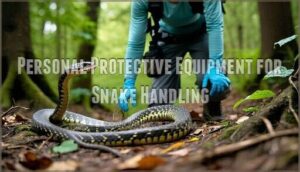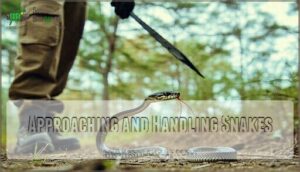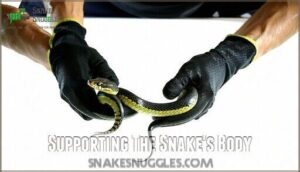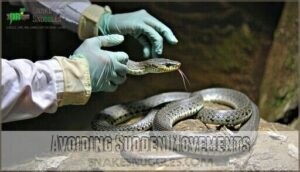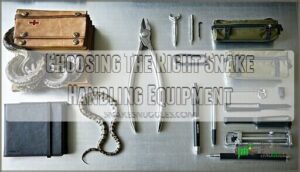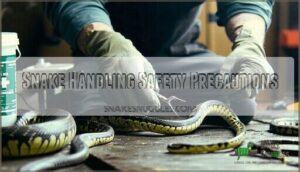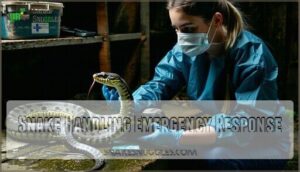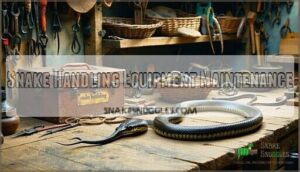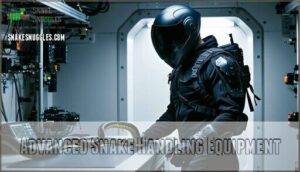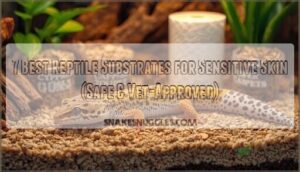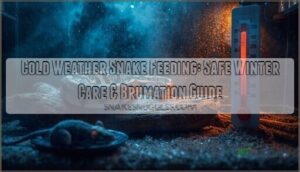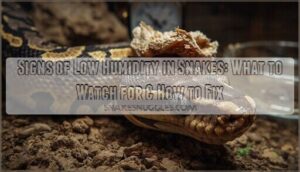This site is supported by our readers. We may earn a commission, at no cost to you, if you purchase through links.
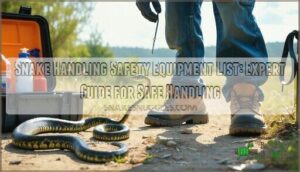
You’ll need snake hooks ranging from 24-60 inches, puncture-resistant gloves rated for animal handling, and sturdy leather boots that cover your ankles.
Secure handling tongs with non-slip grips are vital for maintaining safe distances.
Don’t forget thick denim or canvas clothing, protective eyewear, and secure transport containers with proper ventilation.
A well-stocked first aid kit completes your arsenal.
Remember, the right gear is only half the battle – proper technique and understanding snake behavior patterns separate confident handlers from weekend warriors.
Table Of Contents
- Key Takeaways
- Essential Snake Handling Equipment
- Snake Handling Safety Equipment List
- Personal Protective Equipment for Snake Handling
- Safe Snake Handling Techniques
- Snake Handling Tools and Accessories
- Choosing The Right Snake Handling Equipment
- Snake Handling Safety Precautions
- Snake Handling Emergency Response
- Snake Handling Equipment Maintenance
- Advanced Snake Handling Equipment
- Frequently Asked Questions (FAQs)
- What equipment do you need to handle a snake?
- What PPE is needed for snake catching?
- What is the restraint equipment for snakes?
- What do snake handlers use?
- What equipment do you need to catch a snake?
- How to handle a snake safely?
- Do snake handlers need PPE?
- Are snake handlers safe?
- Who makes the best snake handling tools?
- Where can I find quality snake handling equipment in Africa?
- Conclusion
Key Takeaways
- You’ll need essential distance tools like snake hooks (24-60 inches) and secure handling tongs with non-slip grips to maintain safe separation from potentially dangerous snakes while maintaining precise control.
- Your protective gear arsenal must include puncture-resistant gloves rated for animal handling, sturdy leather boots covering your ankles, thick denim or canvas clothing, and protective eyewear to create multiple barriers against bites.
- You can’t skip secure transport containers with proper ventilation and escape-proof closures, plus a well-stocked first aid kit containing bandages, antiseptic, and emergency contact information for immediate response.
- Your equipment’s only as good as your technique—you’ll need to master slow, deliberate movements, proper body support methods, and stress signal recognition to separate confident handlers from weekend warriors who risk dangerous encounters.
Essential Snake Handling Equipment
You’ll need specific tools to handle snakes safely and protect yourself from potential bites or injuries.
The right equipment creates a barrier between you and the snake while allowing you to maintain control during handling procedures, which is crucial for safe and effective snake handling, and the equipment must be used to protect yourself.
Snake Hooks and Tongs
Snake hooks and tongs form your primary defense against dangerous bites during reptile control.
These venomous snake hooks let you maintain a safe distance while managing serpents with precision. Quality snake tongs feature steel cable mechanisms and ergonomic grips for superior hook safety.
Choose aluminum or telescopic designs based on snake size—hooks work best for heavier species, while tongs excel with smaller reptiles. Professional-grade tools with proper grip techniques guarantee both handler and snake remain unharmed during necessary relocations.
When selecting equipment, consider the importance of proper snake hook designs to guarantee effective and safe snake handling.
Snake Handling Gloves
Your hands deserve armor when handling serpents. Snake handling gloves made from puncture-resistant materials provide essential hand protection while maintaining finger dexterity for precise movements.
Quality leather gloves or welders gloves offer superior grip control and wrist support.
Consider these protective gear features:
- Cut-resistant kevlar weaving
- Extended cuff coverage beyond wrists
- Reinforced palm and fingertip zones
- Flexible joints for natural hand movement
- Non-slip textured surfaces for secure grip
Snake Enclosures and Containers
Beyond protective gloves, you’ll need proper snake enclosures to maintain container safety during handling operations.
Professional snake cages feature reinforced enclosure materials and secure lids that prevent escapes. Habitat boxes and snake confinement boxes provide temporary housing, while specialized snake bags serve as essential snake transport gear.
Your reptile handling equipment arsenal isn’t complete without reliable containment systems.
Snake Restraints and Escape Prevention
Securing your snake’s enclosure prevents escape artistry that’d make Houdini jealous. Restraint tubes and secure containers with robust locking mechanisms provide foolproof containment.
Snake bags with reinforced seams handle transport safely, while escape nets catch any breakout attempts. Snake tongs and snake handling gloves give you control during transfers.
Quality snake restraint tools and snake control devices guarantee your serpent stays exactly where you want them. Understanding proper snake handling safety is vital for a successful and safe handling experience.
Snake Handling Safety Equipment List
Your essential snake handling safety equipment list forms the backbone of every successful reptile encounter.
Professional handlers rely on Snake Hooks and snake tongs for maintaining safe distances while controlling even aggressive specimens. These tools provide precise control without risking direct contact.
Venom Protection starts with puncture-resistant gloves specifically designed for snake handling gloves applications. Quality snake safety gear includes reinforced materials that can withstand strikes from venomous species.
Reptile Handling requires secure transport containers with proper ventilation and escape-proof closures. Snake bite protection extends beyond gloves to include thick boots and protective clothing.
Emergency Kits should contain bandages, antiseptic, and emergency contact information for local medical facilities. Safety Gear must be inspected regularly and replaced when worn.
Remember, snake handling safety equipment isn’t optional – it’s your insurance policy against potentially life-threatening encounters with dangerous reptiles.
Personal Protective Equipment for Snake Handling
You’ll need specific protective gear to shield your body from potential snake bites and injuries during handling procedures.
Proper personal protective equipment creates multiple barriers between you and the snake, substantially reducing your risk of harm while ensuring safe interactions.
Long Sleeves and Pants
Your clothing serves as essential protective gear against snake encounters. Long sleeves and pants made from thick, tightly-woven clothing materials create a barrier between you and potential bites.
Key fabric choice considerations for ideal safety features:
- Dense weave cotton or canvas materials
- Light colors for enhanced snake visibility
- Full arm and leg coverage without gaps
- Reinforced garment design at vulnerable areas
Smart personal protective equipment starts with proper attire selection.
Snake Handling Boots
Your feet face the frontlines when handling snakes, making snake handling boots your most important protective gear.
These thick boots feature puncture-resistant materials and high ankle protection to prevent fang penetration. Look for waterproofing and insulation for comfort during extended use.
When handling snakes, understanding snake handling safety is vital for preventing accidents.
| Feature | Requirement |
|---|---|
| Boot Materials | Leather or Kevlar construction |
| Ankle Protection | Coverage above ankle bone |
| Sole Durability | Non-slip, puncture-resistant |
| Waterproofing | Sealed seams and coating |
| Insulation | Temperature regulation system |
Choose boots with snug fits for maximum mobility and safety.
Protective Eyewear
After securing your feet with proper snake handling boots, protective eyewear becomes your next line of defense.
Safety glasses with shatterproof lens materials and durable frames protect against snake strikes and debris. Anti-fog coatings maintain clear vision during tense moments.
Face shields offer additional coverage for high-risk encounters. Quality eye protection complements your personal protective equipment arsenal perfectly.
First Aid Kits
Three seconds can make the difference between life and death when snake bites occur during handling operations.
Your first aid kit requires specialized medical supplies for effective emergency response.
- Wound care antiseptics and sterile gauze pads
- Compression bandages for bite site management
- Emergency kits contact information for poison control
- Antivenom supplies reference guide and medical attention protocols
Keep supplies current and accessible always.
Safe Snake Handling Techniques
You’ll need proper techniques to handle snakes safely and minimize stress for both you and the reptile.
These methods focus on controlled movements, correct body support, and reading the snake’s behavioral signals to prevent defensive reactions.
Approaching and Handling Snakes
Approaching snakes requires understanding snake behavior and following safety protocols for successful reptile interaction.
Move slowly and deliberately, avoiding sudden gestures that trigger defensive responses. Always approach from the side rather than overhead to minimize perceived threats.
Use proper snake handling equipment like snake tongs or snake hooks for venomous species. Watch for stress signals – rapid tongue flicking and defensive posturing indicate you should back away immediately.
Handling snakes safely involves learning about snake handling techniques to minimize risks.
Supporting The Snake’s Body
When body support becomes your priority, cradle the snake’s midsection with both hands for proper weight distribution.
Your gentle handling technique should create a stable bridge that prevents strain.
Use snake handling gloves for better grip while maintaining safe lifting practices.
This snake restraint method keeps both handler and reptile comfortable, ensuring smooth, controlled movements throughout the interaction.
Avoiding Sudden Movements
Mastering the art of snake handling safety equipment requires deliberate, controlled movements that prevent defensive responses.
Quick motions trigger stress and potential strikes.
Follow these snake safety protocols for Calm Handling:
- Slow Approach – Move like you’re underwater
- Gentle Touch – Apply pressure gradually
- Smooth Movement – No jerky shifts
- Quiet Action – Minimize noise and vibration
Your venomous snake safety depends on these reptile handling safety fundamentals.
Recognizing Stress Signals
When handling any reptile, you’ll need to read their body language like a safety manual.
Stress signs include rapid tongue flicking, aggressive hissing, and defensive coiling—your snake’s warning that trouble’s brewing.
| Warning Signals | Threat Response | Snake Behavior |
|---|---|---|
| Rapid tongue flicking | Immediate retreat | High stress level |
| Aggressive hissing | Defensive posturing | Fear response |
| Tight coiling | Strike preparation | Maximum alert |
Understanding snake behavior prevents bites better than any snake handling safety equipment.
These reptile handling safety cues apply whether you’re using snake handling techniques with non-venomous species or require venomous snake safety protocols.
Snake Handling Tools and Accessories
Beyond hooks and tongs, you’ll need specialized accessories that support safe snake handling operations.
These tools include secure transport bags, feeding equipment, water systems, and monitoring gauges that guarantee both handler safety and snake welfare during extended interactions.
Snake Handling Bags and Pouches
Quality snake handling bags serve as your mobile safety vault during transport operations.
These specialized containers feature secure closures and breathable materials that protect both handler and reptile.
Your gear becomes your lifeline when seconds separate safety from disaster in the snake handling world.
Essential snake bags and pouches include:
- Canvas snake bags with drawstring closures for medium-sized species
- Mesh pouches offering maximum ventilation during short transfers
- Double-layer protective gear with reinforced seams for venomous species
- Collapsible storage options that save space while maintaining transport safety
Choosing the right snake handling equipment involves considering snake handling bag materials.
Choose bag materials and pouch designs matching your specific snake safety equipment needs.
Snake Feeding Equipment
Beyond secure transport solutions, you’ll need specialized snake feeding equipment to maintain safe distances during mealtime.
Professional handlers rely on precision tools that eliminate direct contact risks.
Your feeding arsenal should include these critical components:
- Feeding tongs with extended reach and secure grip mechanisms
- Snake feeders designed for controlled prey delivery
- Food containers with ventilated, escape-proof lids
- Water bowls with stable, tip-resistant bases
- Feeding forceps for precise portion control
Quality snake feeding equipment transforms potentially dangerous feeding sessions into controlled, predictable procedures.
Snake Water and Hydration Systems
Water quality forms the foundation of your snake’s health during handling procedures.
You’ll need systems that maintain proper water temperature and support effective hydration systems. Clean water prevents contamination that compromises snake drinking behaviors.
| Water System Type | Temperature Range | Maintenance Frequency |
|---|---|---|
| Standard Bowls | 70-80°F | Daily cleaning |
| Heated Systems | 75-85°F | Weekly deep clean |
| Filtration Units | 72-78°F | Monthly filter change |
| Misting Systems | 68-76°F | Bi-weekly inspection |
| Automatic Dispensers | 70-82°F | Weekly refill check |
The table outlines different types of water systems, including their ideal temperature ranges and required maintenance frequencies, which are crucial for maintaining proper water quality and ensuring the system operates effectively.
Snake Temperature and Humidity Gauges
Proper hydration sets the stage, but environmental monitors keep your snake thriving. Temperature gauges and humidity sensors aren’t just accessories—they’re lifelines for reptile health.
- Digital snake thermometers provide precise readings within 0.1°F accuracy
- Dual-zone monitoring tracks basking and cool areas simultaneously
- Gauge calibration monthly prevents costly environmental mistakes
Smart temperature control beats guesswork every time.
Choosing The Right Snake Handling Equipment
You’ll need to match your equipment to the specific snake species you’re handling, as venomous snakes require different tools than non-venomous ones.
Quality equipment that’s durable and easy to use will keep both you and the snake safe during handling procedures.
Considering The Snake Species
When selecting snake handling safety equipment, you’ll need to match your gear to your specific snake species like pieces of a puzzle.
Species identification determines everything from hook length to glove thickness.
Venomous snakes require heavy-duty snake protection gear, while docile corn snakes need basic tools.
Snake behavior varies dramatically – aggressive species demand longer tongs, while calm pythons allow closer handling.
Habitat analysis and species classification guide your equipment choices.
Your reptile handling safety equipment should reflect each snake’s unique temperament, size, and defensive capabilities for maximum protection.
Evaluating Equipment Quality and Durability
Quality snake handling equipment separates weekend hobbyists from seasoned professionals.
Your gear’s material testing and durability checks determine whether you’re holding reliable tools or potential hazards.
Professional-grade safety equipment undergoes rigorous quality control processes and meets established safety standards.
Investing in proper snake handling gear is essential for preventing accidents.
Consider these equipment inspection priorities:
- Steel components resist corrosion and maintain structural integrity
- Reinforced joints prevent catastrophic failure during critical moments
- Laboratory certifications validate manufacturer claims about strength
- Extended warranties demonstrate confidence in durable equipment construction
- Field-tested endorsements from experienced handlers confirm real-world performance
Professional equipment isn’t expensive—it’s priceless when preventing accidents.
Assessing Equipment Ease of Use and Safety
Equipment Testing reveals which snake handling safety equipment truly delivers.
You’ll want protective gear with intuitive Safety Features that enhance your User Experience.
Test punctureresistant gloves for grip and dexterity.
Evaluate how snake safety devices perform during actual Handling Techniques.
Conduct thorough Risk Assessment of each tool’s ergonomics, balance, and reliability before trusting your safety to any snake handling equipment.
Snake Handling Safety Precautions
Following proper safety precautions creates a secure environment that protects both you and the snake during handling procedures.
These essential protocols reduce bite risks, prevent escapes, and guarantee safe conditions for successful snake management.
Preventing Snake Bites and Escapes
Three critical steps separate safe snake handling from dangerous encounters.
Your snake safety depends on proper escape prevention and bite protection through proven handling techniques.
Smart snake control starts with the right protective gear and calm movements:
- Wear puncture-resistant gloves and over-the-ankle boots for maximum bite protection
- Use snake handling safety equipment like hooks and tongs to maintain safe distance
- Step on logs instead of over them to avoid surprising hidden snakes
- Keep snake enclosures secure with proper lids and locks to prevent escapes
Understanding proper snake handling safety is essential for preventing accidents and ensuring a safe experience.
Ensuring Proper Ventilation and Lighting
Proper Air Quality and Lighting Systems create the foundation for safe snake handling environments.
Fresh airflow prevents respiratory issues while Ventilation Controls maintain ideal conditions.
Your reptile handling safety protocols should include Temperature Monitoring and Humidity Management systems that work together seamlessly.
Airflow Matters UVB Critical
Well-designed ventilation and lighting systems in your snake handling safety equipment setup reduce stress-related escapes while supporting healthy snake behavior during handling sessions.
Maintaining a Clean and Hygienic Environment
Clean environments prevent disease outbreaks and keep your snakes healthy. Sanitation Methods protect both handler and reptile from harmful bacteria and parasites.
Follow these Hygiene Practices:
- Disinfecting tools with reptile-safe Cleaning Products after each use
- Cleaning enclosures weekly using proper Disinfection Techniques
- Storing equipment in sterile containers following Sterilization Procedures
Regular inspecting guarantees your workspace stays contamination-free.
Supervising Children and Inexperienced Handlers
Vigilant supervision transforms snake encounters into safe learning experiences. Child safety demands constant attention when inexperienced handlers approach reptiles.
Establish handler training protocols before any contact occurs. Your supervision tips include maintaining arm’s reach distance, demonstrating proper snake handling safety techniques, and ensuring protective gear fits correctly.
Never permit unsupervised access. Emergency protocols and risk assessment skills prevent accidents through proactive children supervision measures.
Snake Handling Emergency Response
When you’re handling snakes, emergencies can happen despite your best preparation and safety measures.
You’ll need to know how to respond quickly to snake bites, escapes, aggressive behavior, and when to seek immediate medical attention.
This includes understanding the importance of immediate medical attention in certain situations.
First Aid for Snake Bites
When a snake bite occurs, wound cleaning becomes your top priority for effective first response. Wash the bite area with soap and water immediately to prevent infection.
Keep the bitten limb below heart level to slow venom removal through circulation. Call emergency services right away – time matters more than identifying the snake.
Monitor bite symptoms like swelling, nausea, or breathing difficulty. Your first aid kit should include clean bandages and contact information for emergency care.
Avoid tourniquets, ice, or cutting the wound. Professional snake safety equipment includes proper medical supplies for these situations.
Responding to Snake Escapes
Snake bites aren’t your only emergency concern. When your serpent slips away, quick thinking saves the day. Secure all doors and windows immediately to block escape routes.
Your emergency response requires systematic crisis management and the right snake removal equipment.
- Deploy snake traps strategically near warm hiding spots
- Use protective gear while searching methodically room-by-room
- Activate containment protocols to prevent neighborhood wandering
Dealing With Aggressive Snakes
When aggressive behavior strikes, your snake handling equipment becomes your lifeline.
Use snake tongs or snake hooks to maintain distance while the serpent displays snake defense mechanisms.
Reptile psychology shows that hissing and coiling signal stress.
Your protective gear and snake handling gloves shield against potential snake attacks.
Stay calm, move slowly, and let your tools handle the situation.
| Warning Sign | Your Response |
|---|---|
| Hissing loudly | Back away slowly |
| Coiled position | Use snake hook |
| Rapid tongue flicking | Avoid sudden moves |
| Raised head | Maintain distance |
| Strike positioning | Ready your tongs |
Seeking Medical Attention
Medical Response becomes critical when venomous snakes deliver their dangerous payload. Snake bite emergency care demands swift action and professional hospital treatment.
Your survival depends on these essential steps:
- Identify the snake species if safely possible
- Call 911 immediately for emergency medical services
- Keep the bite area below heart level
- Remove jewelry and tight clothing near the wound
Stay calm, move fast.
Snake Handling Equipment Maintenance
Your snake handling equipment won’t protect you if it’s compromised by wear, contamination, or improper storage.
Regular maintenance extends equipment life and guarantees your safety tools function correctly when you need them most, which is crucial for handling equipment.
Cleaning and Disinfecting Equipment
After each handling session, proper cleaning keeps your gear battle-ready.
Disinfect snake handling tools with veterinary-grade sanitizing solutions immediately after use.
Scrub hooks, tongs, and protective gear thoroughly using appropriate cleaning products to eliminate bacterial contamination.
| Equipment Type | Decontamination Methods |
|---|---|
| Metal Tools | Alcohol-based disinfectant wipes |
| Fabric Items | Machine wash with antimicrobial detergent |
| Plastic Containers | Bleach solution soak |
| Leather Gloves | Specialized leather sanitizing solutions |
Equipment sterilization prevents cross-contamination during future encounters.
Storing Equipment Properly
Proper Equipment Storage protects your investment and guarantees reliability when you need it most.
Store your snake handling equipment storage in climate-controlled environments away from temperature extremes and humidity.
Gear Organization prevents damage and contamination.
- Use Secure Containers with airtight seals for small tools and accessories
- Hang hooks and tongs vertically to prevent warping or bending
- Separate clean equipment from used items requiring Tool Sanitizing
Inspecting Equipment Regularly
Regular Equipment Checks protect you from dangerous failures during snake encounters.
Conduct Safety Inspections monthly, examining hooks for cracks, gloves for punctures, and tongs for loose joints.
Tool Verification includes testing grip strength and jaw alignment.
Damage Assessment reveals stress fractures before they become safety hazards.
Consistent Regular Maintenance guarantees your snake handling equipment maintains peak performance when lives depend on it.
Replacing Worn or Damaged Equipment
Think of worn snake handling equipment like a safety net with holes—it won’t catch you when you fall.
Equipment inspection reveals cracks in hooks, frayed gloves, or damaged containers that compromise your safety protocols.
Damage assessment guides replacement scheduling; don’t wait for failure.
While maintenance costs seem steep, they’re nothing compared to medical bills from snake bites.
Invest in quality snake handling equipment replacement with proven safety features—your life depends on reliable gear, not wishful thinking.
Advanced Snake Handling Equipment
You’ll encounter specialized equipment that goes beyond basic hooks and tongs when handling venomous species or conducting advanced research.
These professional-grade tools include aircraft-grade restraining tubes, titanium-reinforced protective gear, and precision monitoring systems that guarantee maximum safety for both handler and snake, ensuring maximum safety.
Specialized Snake Handling Tools
Professional snake wranglers rely on specialized tools that transform dangerous encounters into controlled interactions.
Your safety gear is the thin line between controlled handling and a trip to the emergency room.
These precision instruments separate novices from experts in the field.
Essential specialized equipment includes:
- Telescoping snake hooks with aircraft-grade materials and ergonomic grips for extended reach
- Professional snake tongs featuring padded restraint mechanisms and variable pressure control
- Snake grabbers with innovative tong designs and handling pincers for secure grip
Quality hook materials and reptile tongs guarantee your safety during critical moments.
Mastering proper snake handling techniques is vital for a successful and safe snake handling experience.
High-Tech Snake Enclosures and Monitoring Systems
Smart Enclosures with Sensor Technology transform snake care into precision science.
Video Monitoring lets you observe behavior without disturbance, while Climate Control systems maintain perfect conditions automatically.
Automated Feeders guarantee consistent nutrition schedules.
These hightech enclosures represent the future of snake safety equipment – your reptile’s digital bodyguard that never sleeps or takes breaks.
Innovative Snake Handling Gloves and Protective Gear
Advanced monitoring systems aren’t the only innovation transforming snake handling safety.
Innovative gloves now feature multi-layered glove materials like Kevlar and titanium mesh, offering superior puncture resistance. Modern protective suits include integrated arm protectors and finger shields that maintain dexterity while preventing bites.
These snake safety suits represent cutting-edge personal protective equipment, combining lightweight design with maximum protection. You’ll find hand guards that flex naturally, making complex handling tasks safer than ever before.
Frequently Asked Questions (FAQs)
What equipment do you need to handle a snake?
Coincidentally, you’ll need the same gear professionals use: snake hooks or tongs for distance control, puncture-resistant gloves, thick boots covering ankles, long sleeves, and secure transport bags.
Don’t skimp on safety equipment.
What PPE is needed for snake catching?
You’ll need puncture-resistant gloves, thick over-the-ankle boots, long-sleeved clothing, and snake gaiters. Don’t forget protective eyewear and consider venom-resistant gear when dealing with venomous species for maximum safety.
What is the restraint equipment for snakes?
You’ll need snake tongs and hooks for controlling movement, restraining tubes for secure containment during procedures, and handling bags with tight closures for safe transport.
These tools maintain distance while ensuring both your safety and the snake’s, which is crucial for handling snakes.
What do snake handlers use?
You’ll rely on snake hooks and tongs for distance control, puncture-resistant gloves and boots for protection, plus handling bags for transport.
Professional handlers also use restraining tubes and specialized forceps to guarantee everyone’s safety.
What equipment do you need to catch a snake?
You’ll need snake tongs or hooks to maintain safe distance, puncture-resistant gloves, thick boots covering your ankles, and secure transport bags.
Don’t forget protective eyewear and long-sleeved clothing for complete protection.
How to handle a snake safely?
One wrong move could spell disaster.
Always use snake hooks or tongs to maintain distance.
Support the snake’s body evenly, move slowly, and wear protective gear.
Never grab the head directly—let the tools do the work.
Do snake handlers need PPE?
Yes, you’ll need thorough PPE when handling snakes.
Essential gear includes puncture-resistant gloves, thick boots, long sleeves, and protective eyewear.
This equipment shields you from bites and creates a vital safety barrier.
Are snake handlers safe?
Walking a tightrope without a net describes handling snakes improperly.
You’re reasonably safe when you use proper protective equipment, follow correct techniques, and maintain respectful distance.
Training and quality gear transform danger into manageable risk.
Who makes the best snake handling tools?
Midwest Tongs dominates the snake handling tool market with over 40 years of experience.
You’ll find their products field-tested by Animal Planet’s Mark O’Shea and National Geographic’s Snake City experts, ensuring professional-grade safety and reliability.
Where can I find quality snake handling equipment in Africa?
Finding snake equipment in Africa isn’t exactly like shopping for groceries.
You’ll need to import quality tools from reputable US manufacturers or contact specialized wildlife supply companies that ship internationally to African countries.
Conclusion
Better safe than sorry" rings especially true when handling snakes.
Your snake handling safety equipment list forms the foundation of responsible reptile management. Proper hooks, protective gloves, secure containers, and first aid supplies aren’t optional—they’re essential.
Remember, quality equipment paired with proper technique creates a safety barrier between you and potential danger.
Regular maintenance and inspection of your gear guarantees it’ll perform when you need it most. Smart handlers invest in safety first.

